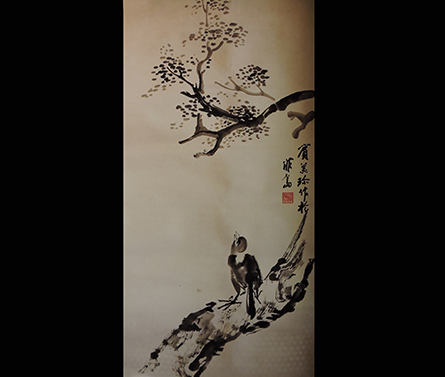
Chinese ink art of Marian Bingham ’91 on display at Conn
The Chinese ink art of contemporary American artist Marian “Bing” Bingham ’91, which showcases her unique journey of studying and creating Chinese ink paintings spanning decades and continents—from California to Hong Kong, to Manila, and back to Connecticut—is on display in the Charles Chu Asian Art Reading Room in Conn’s Charles E. Shain Library until June 15.
Bingham’s displayed work honors three important teachers who inspired her undertaking at different points of her life, including her father, Woodbridge Bingham (1901-1986), a pioneering sinologist and professor of East Asian history at the University of California, Berkeley, and founder of their Institute of East Asian Studies; and two equally distinguished Chinese painters who carried their own stories as diasporic artists and contributors to cultural communications between East and West: I-Hsiung Ju (1923-2012), the late emeritus professor of art at Washington and Lee University who is considered one of the few Chinese artists able to blend two worlds of style, technique and idiom to produce a unique form of painting that is both modern and traditionally Asian; and Charles Chu (1918-2008), the late emeritus professor of Chinese at Connecticut College and master painter and calligrapher known for his sweeping watercolors.
Born in Oakland, California, in 1940, Bingham was heavily influenced by her father, who served her first teacher and exposed her to Chinese ink art early in her childhood. While she initially had to confront prejudices against women and non-Western art, Bingham’s engagement with different perspectives and art traditions allowed her to develop her own unique style.
“For our viewers … Bingham’s Chinese ink art offers many useful lessons about what can be gained through crossing the seemingly insurmountable East/ West barriers,” said Yibing Huang, associate professor of Chinese and curator of the Chu-Giffis Asian Art Collection at Connecticut College.
“It demonstrates that the highly culturally specific Chinese ink painting tradition, once engaged from a new cross-cultural perspective, may actually yield works that are hybrid, meaningful, contemporary and universal.”
For example, Huang said Bingham’s Bamboo in Snow “can be seen as a work completely within the Chinese ink painting tradition, whose main visual focus is on the robust stems of bamboo, whereas its depiction of the actual snow or physical environment is completely blank and left to the audience’s imagination. On the other hand, we may actually also see it as a contemporary, experimental American art piece beyond the old of Chinese ink art. For viewers from Connecticut, it is almost like Bingham is transplanting Chinese bamboo into a New England winter landscape.
“That is, with its minimalist brushwork and depiction of the actual snow, Bamboo in Snow is full of suggestion and evocative power, instantly expanding its viewer’s horizons and transcending spatial and temporal boundaries.”
“The Chinese Ink Art of Marian Bingham” is free and open to the public Mon.-Fri. from 8:30 a.m.-4 p.m.

